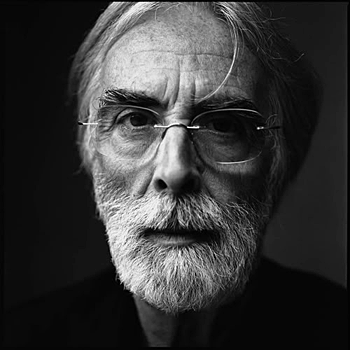The Manipulations in the
Michael Haneke Film Code Unknown.
|

|
>
Michael Haneke
(1942) is an analytical filmmaker, who
focuses on unpleasant themes, which he portrays in a distant, penetrating way.
These typical ingredients of a Haneke film are all evident in Code
Unknown: Incomplete Tales of Several Journeys (2000). Haneke: "In all
my films the structure is cold and analytic. It is also clear, in advance how
the film will be shot. Who knows the script, knows how the film will look.
But
I try to shape my actors into realistic and believable characters".
In
this way, Haneke provokes, despite the chilliness, strong emotions in the
viewer. In the indigestible but masterful Haneke film >
Funny Games
(1997), he
succeeded evoking this tension so well because the topic was violence.
|
| Michael Haneke
|
More harm
Also in >
Code Unknown,
the two most compelling scenes are about violence. But in contrast with Funny
Games good and evil are here ambiguous. Haneke: "The question whether
you should interfere with other people's problems, is not easily answered. The
young African who makes a stand for the Romanian beggar-woman causes more harm
than good. But when nobody interferes, when the agressive boy in the metro
molests the actress Anne, it is just as bad. It's about individual choices
which may turn out wrong. I am not a counsellor, I only show what can
happen".
Complex
The sequence in the metro, which is just like
the other scenes shot in one long continous take, is due to its realistic
ambiguity the most oppressing of the film. Haneke: "That boy is not just
an asshole. Anne's reaction could have been nicer too. But that she has a knot
in her stomach is also understandable. It's very complex. In this scene our
whole social structure is summarised, and also our fear to interfere in
certain situations. You become an accomplice, without you wanting it".
Manipulation
Haneke wants to challenge the viewer
emotionally to get them thinking. Not only about the events in the scene, but
also about the medium itself. What is reality in film? In Code Unknown
the actress Anne, played by Julliete Binoche, plays a part in a film. Haneke:
"I try to trap the viewer, because he's not aware whether he's in the
reality of the film or that he's in the film within the film". The film
within a film sequences start without warning. In one scene Anne suddenly
kisses someone in a swimming pool who is not her friend. Although this scene
appears very suddenly in the film, and is not shot in one plan sequence - a
clear indication it belongs to the film within the film - the viewer still
believes at first instance, because he's caught up in the tension, that it is
the film reality. Haneke wants the viewer to feel how manipulative he is.
Distrust
In the swimming pool scene a child almost falls
from the balcony. The viewer is relieved when it turns out to be a film.
Haneke: "After the scene it becomes clear very soon that it was not real,
but a film within a film. But the joke is, that the viewer has to acknowledge
that the fate of the Romanian beggar-woman or the young African, is also a
invention of mister Haneke. In this way I want to feed the distrust for what
is reality in the cinema".
Here you can find the highly recommended >
Michael
Haneke Film Collection box
More articles on film you can find in our >
Movie
Art section